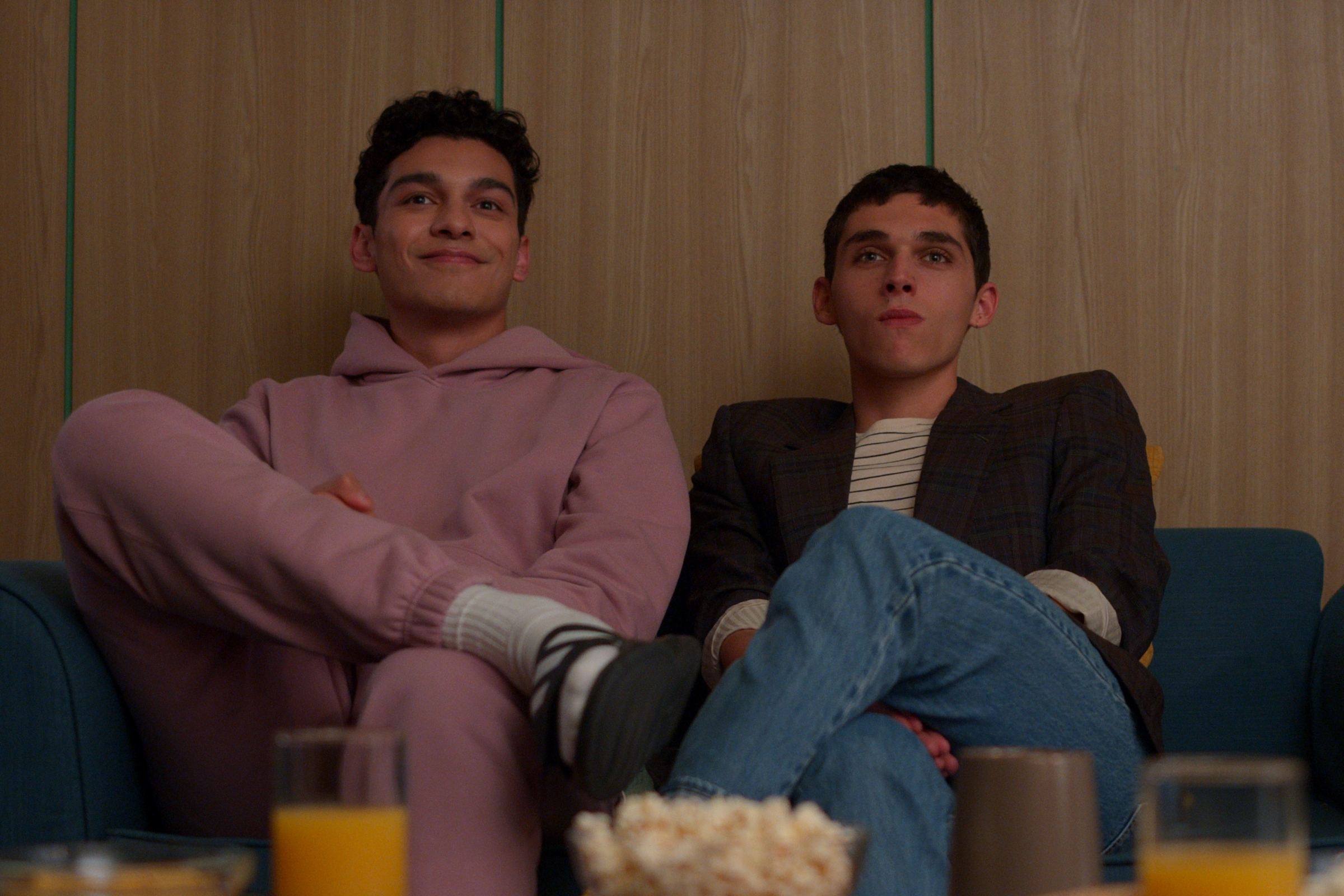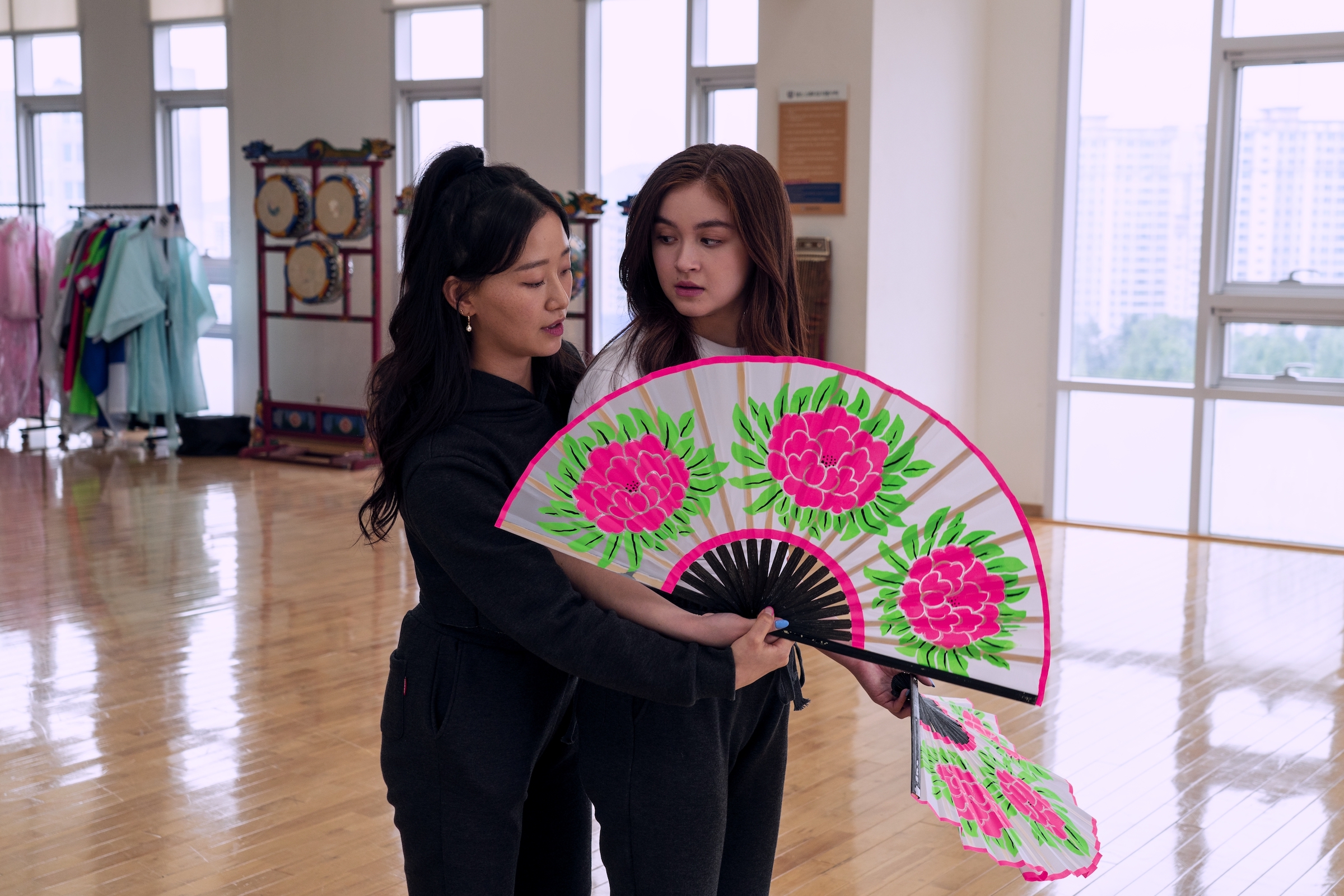In an episode of XO, Kitty—titled “KISS” after the Korean Independent School of Seoul, which the titular Kitty (Anna Cathcart) attends for her junior year of high school—Kitty speculates on the nature of the relationship between Dae, her ex-boyfriend, and Yuri, the principal’s daughter.
“This whole Yuri thing is weird and probably fake,” Kitty tells Q, Dae’s roommate and her new friend, over lunch.
“Weird, yes,” Q (Anthony Keyvan) agrees. “But fake? Come on, life ain’t a K-drama.”
Just then, Dae rounds the corner into the cafeteria. The camera switches to slo-mo, a musical cue brings in wind chimes, and Kitty’s heart beats in her ears. (Choi Min-yeong, the actor who plays Dae, is a real K-drama star, having appeared in a laundry list of popular shows: Magic Thousand Characters, Strong Girl Bong-soon, Mr. Sunshine, Itaewon Class, and Twenty-Five Twenty-One.) Q is wrong: Life, at this moment, is a K-drama.

Slo-mo K-drama scenes and melodramatic K-drama tropes pepper the show, which came to Netflix on May 18. The romantic dramedy, a spin-off of the To All the Boys film series, fuses the soapiness of Korean dramas with the classic beats of American teen shows (think: Freaks and Geeks or Glee) to become a truly international story. (Kitty’s peers at KISS are Korean, American, Australian, Iranian, Filipino, Greek, and French.)
And XO, Kitty adds an unequivocal element that has been gradually gaining traction within K-dramas: multiple prominent queer storylines. In a country that has not always welcomed the LGBTQ+ community (South Korean law does not protect from discrimination based on gender identity or sexual orientation), the inclusion of these full-bodied queer romances is radical.
The K-drama elements that fill XO, Kitty
Another XO, Kitty episode opens on a love montage: As “Stay This Way” by K-pop girl group Fromis 9 plays, three couples—Kitty and Dae, Q and his crush Florian (Théo Augier), Dae’s roommate Min Ho (Sang Heon Lee) and rich girl Madison (Jocelyn Shelfo)—lock lips all around Seoul.
“After so much K-drama, things could not be more perfect,” Kitty thinks to herself.
It’s a clever quip. The “K-drama” Kitty refers to has to do with a fake relationship between Dae and Yuri—her earlier hunch was right. Yuri, the high-profile daughter of KISS’s principal and a hotel magnate, proposed “dating” Dae to throw her mother off of her actual relationship with Juliana (Regan Aliyah), still taboo in South Korean high society. In exchange, Yuri covers Dae’s pricey KISS tuition.
Contract relationships abound in K-dramas. In many of them, enemies—or in Dae and Yuri’s case, complete strangers with nothing in common—become friends and sometimes something more. Dae and Yuri grow close over time; Yuri even comes to Dae’s family Chuseok celebration. But eventually, Yuri learns that her mother is aware of her feelings for Juliana, and ends the fake relationship with Dae, resolving one strand of her personal “K-drama” and beginning another.
Early in the show, Juliana leaves for England, thinking her parents are sending her away. Later, Yuri discovers emails from her mother to Juliana’s parents revealing they know about the relationship between their daughters. “Your daughter, Juliana, is a bad influence on my Yuri,” her mother writes in one email. “Regretfully, I must ask you to make alternative plans for Juliana’s education.”

Grace Jung, who hosts the K-Drama School podcast and wrote the forthcoming book, K-Drama School: A Pop Culture Inquiry into Why We Love Korean Television, notes this plot device is a common one. “It’s quite typical for K-dramas (and most story arcs) to use the family unit as the challenge to overcome, so it’s unsurprising that XO, Kitty employs the same device,” Jung says in an email.
“This storytelling trend is linked to a broader history found in literature worldwide where an outcast begins a hero’s journey,” Jung says. “And the subject must break away from the tribe to find their own individuality and offer change to the world they’re in.”
(Creator, executive producer, co-showrunner, and To All the Boys author Jenny Han and executive producer and co-showrunner Sascha Rothchild declined interviews with TIME given the status of the ongoing Writers Guild of America strike. They also—along with the rest of the XO, Kitty writers—sat out the show’s premiere.)
How XO, Kitty includes multiple queer storylines
Kitty is a self-proclaimed matchmaker—fans of To All the Boys I’ve Loved Before will remember she helped her sister, Lara Jean (Lana Condor), get together with her former crush, Peter Kavinsky (Noah Centineo). In XO, Kitty, she tries to set Q up with his crush, Florian. When Q hesitates, Kitty checks herself.
“Sorry,” she says. “God, I forgot I wasn’t in Portland. And I should not assume that you’re gay, or that you’re out—or assume anything.”
“I am out,” Q says. “Don’t get me wrong, compared to the U.S., Seoul isn’t exactly gay-friendly. But I have family in Iran and the Philippines, so I basically spend every vacation in Hetero Cosplay Summer Camp.”

In a recent cover story for Teen Vogue, Cathcart shared that she was excited about XO, Kitty’s queer storylines and characters, calling them significant, “considering that LGBTQ+ rights and representation are still not widely accepted in the Korean mainstream.”
Multiple queer storylines—Q and Florian’s, Yuri and Juliana’s, Kitty and Yuri’s—collide with societal norms and disapproving parents, marking a noticeable difference from recent American teen shows, like Love, Victor, which features queer characters living their lives openly. But queerness is still integral to Korean entertainment.
Read More: The 10 Best Korean Dramas of 2022 to Watch on Netflix
“Queerness is hyper-present in K-dramas because Korean television frequently employs camp styles and aesthetics,” says Jung. “Queerness goes beyond just representation through characters. It is found in music, wardrobe, makeup, triangulated relationships, excess, and other subtexts.”

Jung notes that queer characters have become more present on screen in Korean TV, citing titles like Itaewon Class, Record of Youth, Hi Bye Mama, and School Nurse Files, which she credits to a rise in LGBTQIA+ activism in South Korea.
XO, Kitty is sprinkled with K-drama moments: Kitty trips on a hike and Dae catches her as she falls. Kitty’s heart thumps as Yuri pulls her hair aside and clasps a necklace around her neck. Time slows and dramatic music plays and Kitty’s love interests are treated as equally worthy, regardless of gender. The show embraces queer love without overdoing it while maintaining the essence of K-dramas.
“K-dramas are designed to be addictive and binge-worthy,” Jung says, “just like bulgogi and honey butter chips.”
More Must-Reads from TIME
- Caitlin Clark Is TIME's 2024 Athlete of the Year
- Where Trump 2.0 Will Differ From 1.0
- Is Intermittent Fasting Good or Bad for You?
- The 100 Must-Read Books of 2024
- Column: If Optimism Feels Ridiculous Now, Try Hope
- The Future of Climate Action Is Trade Policy
- FX’s Say Nothing Is the Must-Watch Political Thriller of 2024
- Merle Bombardieri Is Helping People Make the Baby Decision
Contact us at letters@time.com